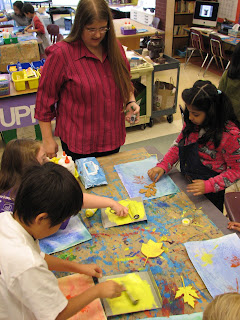This lesson is another favorite from my Student Teaching days, this time at Hermitage High School (Go Panthers!). The idea was to create animal hybrids using Photoshop. These hybrids were to be convincingly merged to make the animal believable. Students had to combine at least 2 animals and add in two textures, so they were blending a minimum of 4 photos. I aimed it at Art I students, who are generally all in the 9th grade. I also had the opportunity to teach this lesson to 8th grade level Art I students, while I was board subbing at Tuckahoe Middle School.
 |
| Demo Model : Bear-Frog made with bear, frog, turtle, moss, and dirt photographs |
I had several goals for the lesson. The first, was to give students a basic understanding of Photoshop and photo-manipulation. I wanted students to understand that Photoshop could be used as a tool to make unique pieces of art. Some of the big topics we covered along the way included: using royalty free images vs. copyrighted images, photo-manipulation vs. photo-merge, raster vs. vector based programs, and resolution and its relation to image size. In addition to those main topics, there were specific aspects and tools in the Photoshop program that were necessary to learn including opacity, layers, the clone stamp tool, selection tools, hue/saturation, eraser, blur, burn, dodge, and move tools.
A note on copyright in regards to this project, it is a biggie! Students were required to use either photos they had taken themselves or royalty free photos (photos that did not need to be paid for). Most websites with royalty free photos only required the user to give credit to the source to use the image (I checked the usage policies on several sites and gave students an approved list of websites they could use). To meet this requirement, students had to fill out a citation list and turn it in with their final project. Copyrighted images were NOT allowed, as that would be copyright infringement and plagiarism. This was a learning experience for many students. Several wanted to use images from movies or comic characters and I actually walked them through how to check if an image was copyrighted, by checking for watermarks and copyright info at the bottom of web pages. As a general rule all movie, art, and comic images were a no-go because they all were sure to be copyrighted. I also had to make sure they clicked and went to the original webpage to cite their source, a ton of students tried to put Google.com or Google Images as their source.
Needless to say, there was a lot to cover and this was a multi-week lesson. It was a process of taking what they learned the previous class and building on it as we went, so all the information was spread out over the classes and easy for students to absorb.
I created step-by-step tutorial handouts for students to reference while they worked (complete with screenshots) and I did several demonstrations. The first demo, was just showing how the tools worked and students had a Practice Assignment to basically try out the tools. After that, I gave a demo on how to merge animals and textures (See Bear-Frog above^^). I made the photos I was using available for them to follow along with me. Two things to note with Photoshop whether you are teaching it or using it yourself: the best way to learn it is to use it hands-on (not just read or listen about it) and there are many different ways to do the same operation or effect (like using menus or hot keys, etc.).
Here are some student examples!





















